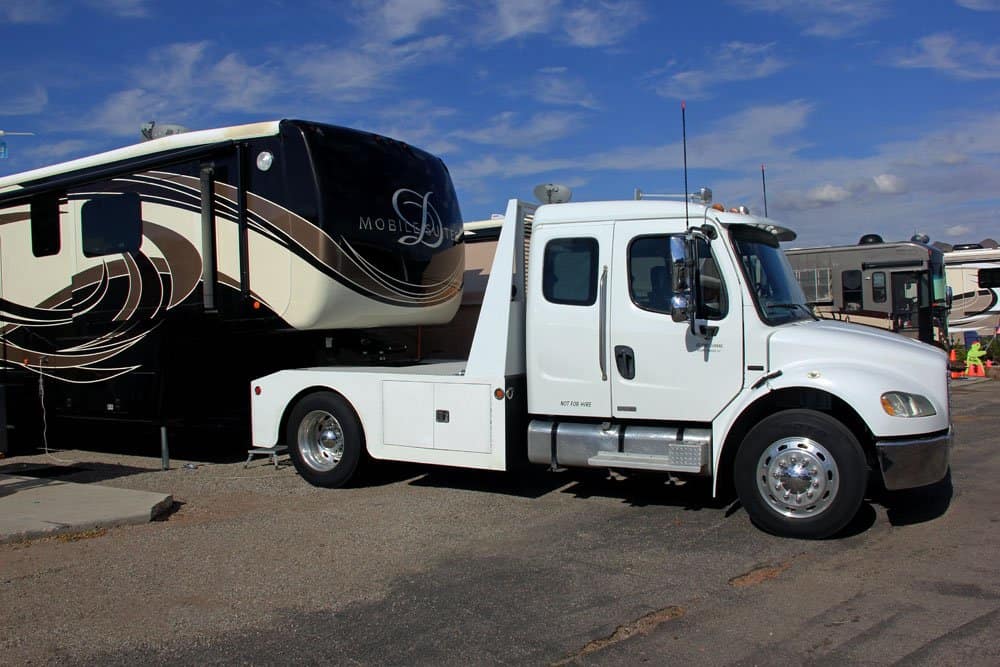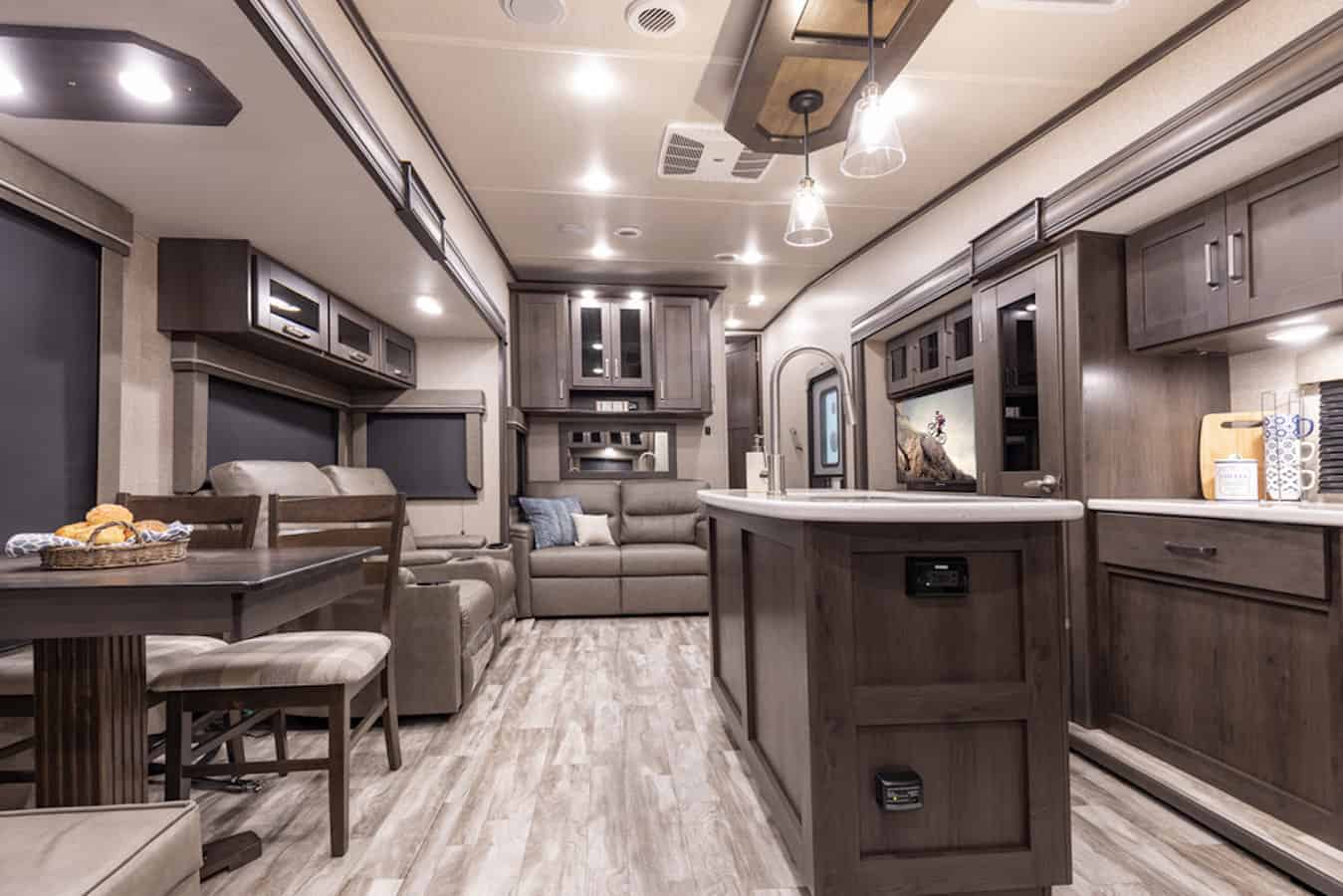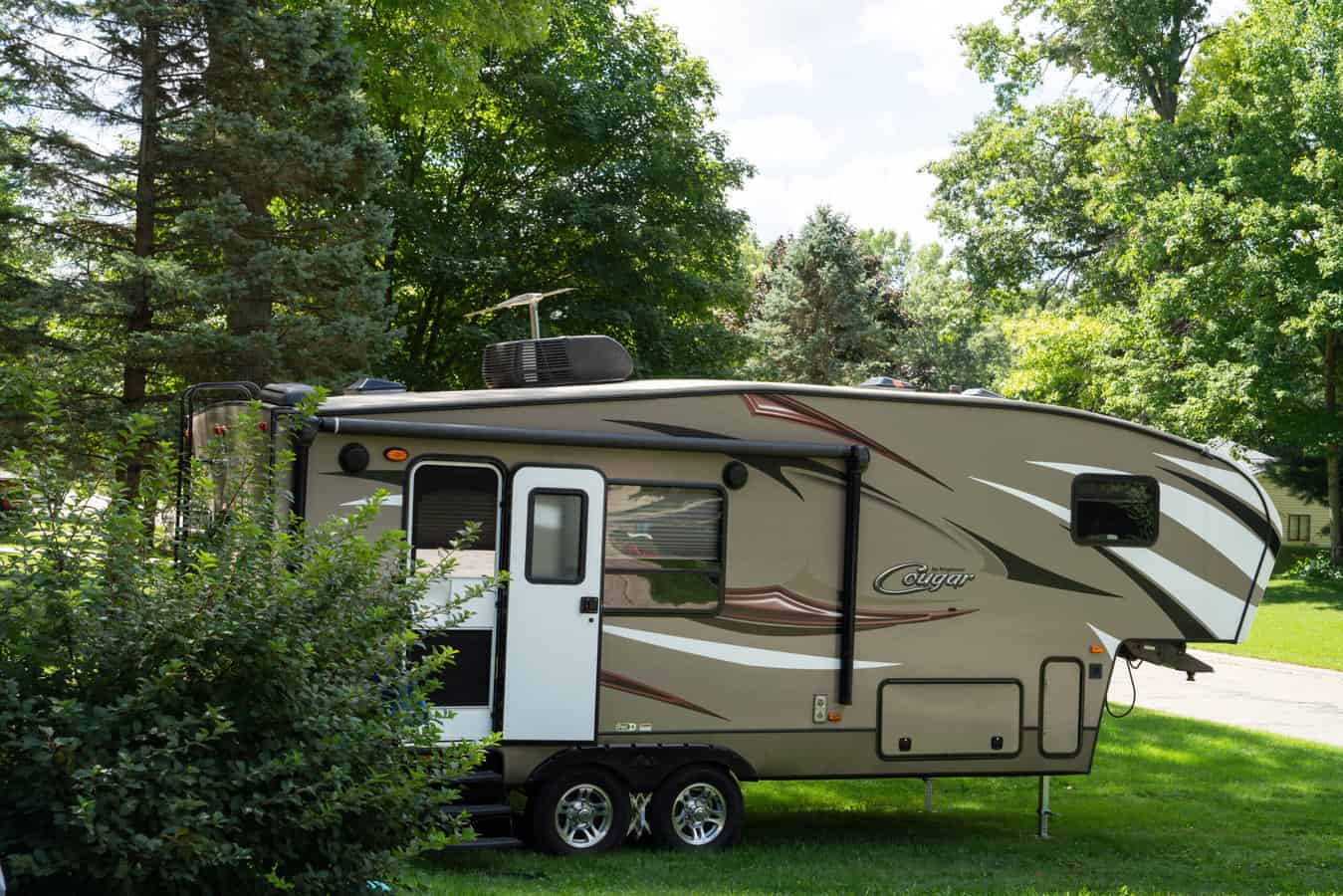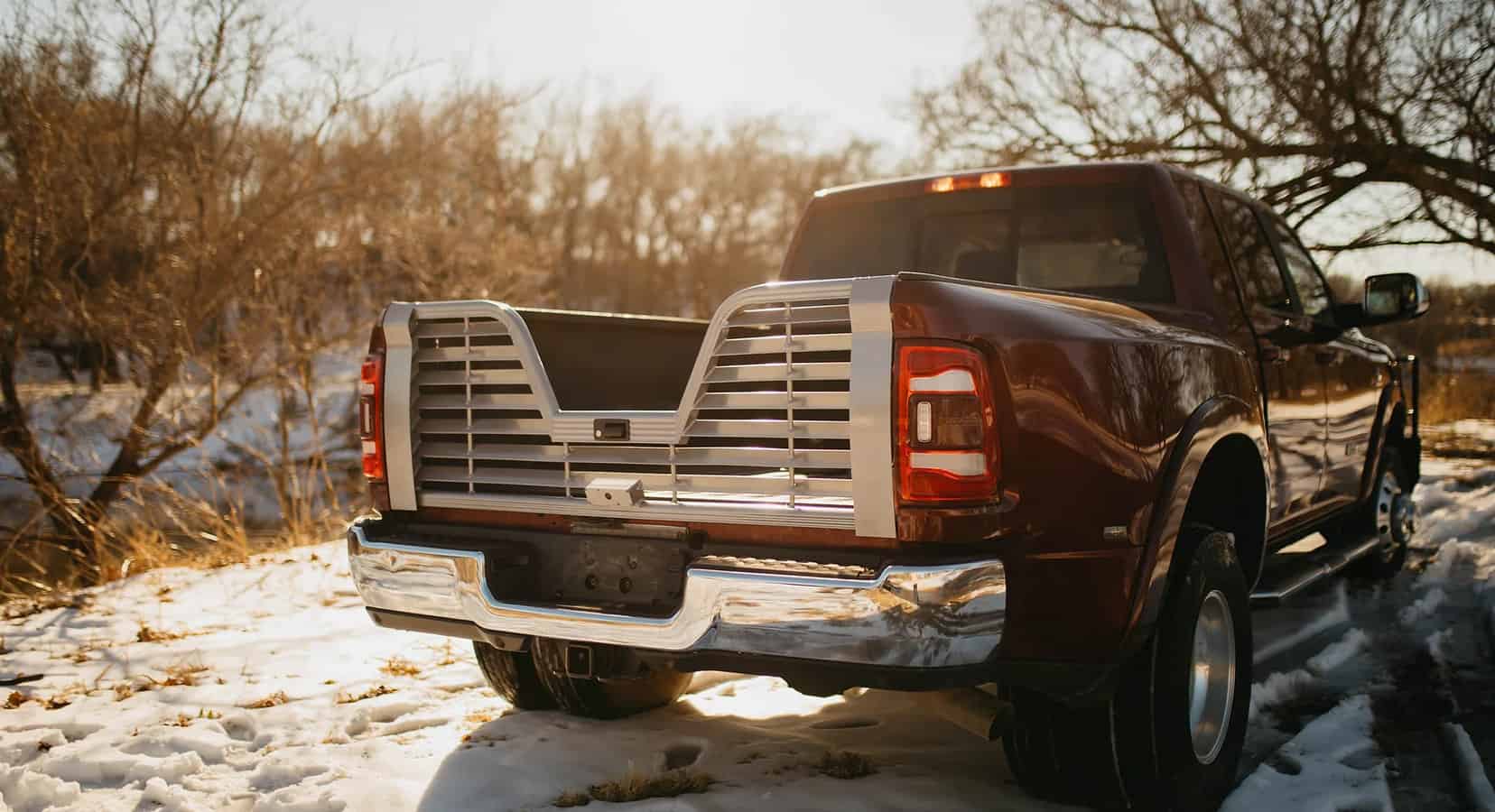
Semi-trucks towing fifth wheels looks impressive and sometimes makes great sense. You may be wondering about the pros and cons of doing it. If so, keep reading, because this article explains why it’s possible to tow a fifth wheel with heavy duty truck, and how to do it.
Semi trucks might seem big, bulky, and unnecessary for RV towing. But when you get past the size of those beasts, you’ll see great reasons for towing fifth wheels with semi trucks. According to this iRV2 Discussion Forums member:
Ten Reasons Why Semi-Trucks Towing Fifth Wheels might be a good idea
- Safety – higher GVWR, superior braking and control.
- No weight limit worries – You can pull the largest trailers, and take all your toys.
- Easy to Drive – automatic transmissions with no clutch.
- Power for passing and climbing – you eat up the toughest mountain passes.
- Quiet, comfortable interiors – designed for the longest trips. End your holiday with a relaxing drive home.
- Operate with a standard driver’s license – plus airbrake certificate in most provinces or states
- Fuel Economy – 10+ MPG (imperial) while towing the largest 5th wheel trailers or horse trailers
- More passenger room – Seats up to 5 comfortably
- Smaller turning radius – turn tighter u-turns than with a motorhome or one ton pickup truck
- Less costly – a used, well maintained semi truck can be cheaper to buy than a 1 ton dually depending on options
In addition, the most popular reason why people tow fifth wheels with semi-trucks include:
Longer life span. Although a new or used semi-truck can cost anywhere from $80,000 to $200,000, you get your money’s worth. Semi-truck can last for about 500,000 miles of heavy duty use. Many engines can run to up to 1,000,000 miles. These are trucks that are built to last for around 4-5 years
What to check before buying a heavy duty truck for your fifth wheel
If the idea of having semi trucks tow fifth wheel trailers sounds appealing, you need to know a few things. Let’s get into some important details like kingpin size, wiring compatibility, towing capacity, and other important towing information critical for the rig combo to work safely.
Check the kingpin and towing level
Kingpins are basically parts of the fifth wheels and semi-trucks that help with coupling and pivoting of the vehicles. This part is often the same dimension across most fifth wheels, semi-trucks, and other commercial vehicles. These trailers often use kingpins that are 2 inches in diameter. If the semi truck kingpin matches that of the fifth wheel, the towing combo can work safely and effectively. Ideally, you want a dedicated RV hitch for full articulation. An air ride hitch is the ultimate add-on.
Sometimes semi trucks come with kingpins that are as large as 3 1/2 inches in diameter. As long as the kingpins match in size the semi can pull the fifth wheel without an issue. If they do not match, you will not be able to tow and will have to look into other options.
Semi-trucks were not technically designed to be pulling fifth wheels or other trailers like them. But there are workarounds. To see if a certain combination of semi-truck and fifth wheel towing setup will work, start by verifying the semi-truck’s towing levels. Why? Because the truck’s pin box must be at the same level as the trailer’s kingpin. If the trailer is not towed as level as possible its nose can be too high or low. This causes instability and issues with swaying and other things. Avoid that situation at all costs.
How to check the towing level on the semi-truck and fifth wheel.
- Park the two vehicles on level ground.
- Measure the distance from the ground to the hitch on the semi-truck.
- Next, measure the distance from the ground to the pin pox of the fifth-wheel.
- Compare the measurements.
If they are the same or close, the trailer’s front end (nose) won’t be too high or low. If the height difference is noticeable, they might not be a good match for each other.
Check the Wiring
Wiring complications are a common issue. The job of locating the right adapters and connecting wires in the correct places may be difficult. That’s why most RVers stick to trucks made by Ford, Chevy, Toyota, and other companies. Most are already set up for towing fifth wheels. This makes it extremely convenient and easy to hook up the fifth wheel trailer.
Semi-trucks with fifth wheels is a more common occurrence these days, but that doesn’t change the fact that semi-trucks weren’t designed to do that job. A semi-trucks’ wiring can be a roadblock to making it happen. To see if a truck’s wiring enables fifth wheel towing, learn everything you can to ensure the truck wiring is compatible with the trailer wiring. Some truck and fifth wheel wiring variables that might keep you from this towing setup include:
- Semi trucks typically have a 7-pin round socket. Fifth Wheels only have a female RV 7-way blade style trailer connections.
- Semi-trucks and other commercial trailers usually operate on a separate wiring system. Fifth-wheel trailers use 2-wire systems with combined brake light and turn signal circuits. The majority of fifth-wheels have electric drum brakes wired to the RV’s 7-way connector. Commercial trucks typically have connectors for trailer lights with separate connections, or they have trailer brakes. For smooth braking of semi trucks towing fifth wheels, you’ll need to rig an after market electric brake controller into the fifth wheel trailer’s connector. An adapter may also be needed to connect a semi truck style connector to that of a RV connector.
Safety Considerations
Once you have checked the kingpin size, wiring, towing level, and wiring of the semi truck and fifth wheel, it’s time to verify the safety of the truck and trailer turning radius. Here’s what you want to check:
1. Truck Cab to Trailer Overhang clearance
Double check that there is enough cab-to-trailer overhang clearance. Measure from the center of the fifth-wheel hitch to the width of the trailer. As an example, if the trailer is 96 inches wide, the distance from the fifth wheel hitch to the semi’s cab must be 52 inches. Confused? Try this equation:
Trailer width/Distance from fifth wheel to Semi cab + 4 inches = Safe clearance.
2. Truck frame and wheels to trailer clearance
Next, you want to know if there is enough turning radius for semi trucks towing fifth wheels. Here’s how find the truck frame and wheel-to-trailer clearance.
- Measure from the center of the fifth-wheel hitch to the back corner of the frame/wheels.
- Then, measure the kingpin on the trailer to the underside of the trailer.
The measurement on the trailer needs to be at least 5 inches greater than the measurement on the truck. If that is the case, then there is enough turning radius.

The Biggest Advantages of Semi-Trucks Towing Fifth-Wheels
The average semi-truck can tow around 40 tons of weight. Many types of passenger trucks with different makes and models are designed and made to pull heavy cargo like trailers and fifth-wheels. But overall, a semi-truck will outperform a passenger truck any day for the following reasons:
- Used semi-trucks with a ton of life remaining can be many times cheaper than a newer passenger pickup truck
- Semi-truck brakes mean that even if you lose your trailer brakes, you can easily stop the largest fifth wheel
- Carrying smart cars, motorcycles, golf carts, scooters, and UTVs on the semi-truck isn’t a problem
- Better responsiveness when backing up and turning
Lots of experienced RVers love the freedom a heavy duty truck brings to the open road. If this sounds appealing, talk to RVers with heavy duty trucks towing their fifth wheel trailers. Here are more resources for HDT truck owners with fifth wheels:
iRV2 Discussion Forum Topic: Truck Conversions, MDTs, & HDTs
Escapees Discussion Forums: Heavy Duty Trucks




Can I safely pull a fifth wheel camper with my semi truck? I still use it for work but I also want to be able to pull my fifth wheel camper. Is this possible??? Or do I need a different fifth wheel hitch to do this??? I need accurate info please!
Tia
Did you actually research anything for this article? This is riddled with false information.
I wanted to chime in and make some comments as an admin of the largest of three HDT (heavy duty trucks) groups on Facebook that are dedicated to towing a RV 5th wheel with a class 8 semi truck. (www.fabebook.con/groups/hdtrvs). Even before the Facebook groups, the Escapees RV forum (rvnetwork.com) had a dedicated HDT section that by far surpasses any other sections on that forum with guys that have been doing this for 10-15 years. It certainly isn’t new using a HDT to tow a 5th wheel although it’s caught a lot more attention in the last couple years since the size of RV’s just keep growing and let’s face it most 2500’s run out of payload way too quickly for the new “normal” in RV 5th wheels. Some of the largest 5thb wheels by Space Craft, New Horizons, DRV and others are getting to the point you just can’t tow then with a 3500 pickup.
First off one the huge advantages of a HDT is their useful life. Sorry to say but 200k is just getting broken in and would be considered really low mileage on HDT. Most people are happy to get a truck in the 500-600k miles. Many trucks are expected to last result easily 750k-1mil miles and in RV life they are living in easy life accumulating way less miles than they did in commercial duty, so they generally last way longer.
Another attractive advantage of HDT for many is price. You can buy a used HDT truck that has a ton of life left in it for many times cheaper than a newer pickup and a way longer life cycle. I bought a Volvo truck in 2017 that was 17 years old with only 480k original miles, yet it has been in RV duty for over 13 years. It was a fraction of the cost of a new pickup and a real gem to find.
The safety aspect is often another attraction for many people. Although the towing capacity of newer trucks is getting impressive, the fact remains that a larger 5th wheel can out weigh a pickup by 2x-3x. If you lose your brakes on the trailer, that truck is going to struggle to stop the trailer and there are other instances where that trailer can definitely push the truck around. On the other hand a HDT often times is usually much closer to the weight of the 5th wheel and the much larger brakes of the trucks mean that even if you lose your trailer brakes, you can easily still stop the 5th wheel. There is just no comparison carrying a 5th wheel on a HDT which is easy life for the HDT.
There are other advantages of having such a large tow vehicle in that you actually can carry an every day car on the back of it. The smart car has been a popular choice to carry on the back of the HDT as it’s the only car that fits sideways behind the cab. Carrying motorcycles, golf carts, scooters, Spyders are also popular options. There is also the option to carry a fun you like a Jeep Wrangler or UTV length wise behind the cab. In any case you get the best of both worlds of a great tow vehicle and then a much nicer vehicle to drive around and not have a dually as your daily driver like so many RV’ers do.
You mentioned a couple other points to tackle. Although a 2″ commercial hitch will work as you said, the general consensus is that you should really use a dedicated RV hitch to get full articulation and most of us take that one step further and get an air ride hitch like trailer saver, ET hitch, comfort ride, and others. The air ride hitch gives the 5th wheel an awesome ride
Turning radius is another surprising advantage. The aero trucks with a set back front axle have some amazing wheel cut, often times in the 52-55 degree range, and absolutely blow the 3500 trucks out of the water on how sharp they turn. You also have the option with a HDT, unlike a pickup, to mount the hitch several feet behind your rear axle. This is especially true if you carry a smart car or something else behind the cab. Since the pin weight of a RV is a fraction of the weight of a commercial trailer and the hitch can be further back, now you have a 5th wheel that follows the truck much better in turns and when backing up the trailer responds so much quicker to steering inputs. I’m amazed at some of the places I can put a 5th wheel with my HDT. It’s definitely not a disadvantage as pointed out in your article.
I was excited to see an article on this topic but there’s a lot of mis-information that I felt should be addressed to give your readers another angle for actual HDT owners. Using a HDT/semi isn’t for everyone but it’s certainly an option that fits some people really well.
Can you elaborate on using the fifth wheel on a semi? I’ve done a little research on this but haven’t gotten a definitive answer. I want to be able to pull a fifth wheel with my semi truck but I’ve been told I need to only use a “RV fifth wheel hitch” and that the fifth wheel on my semi will put too much strain on the fifth wheel camper? Is this true or what is your opinion on this? Tia
Please go to the Escapees forum and HDT page and read the notes. There are thousands of us pulling heavy 5th wheel RV’s with HDTs. A proper air ride hitch with a wiring converter is all it takes. Trucks can be registered at RVs as well. Our DRV Mobile Suite weighs 24800 lbs, and would squash a Toyota truck. The pin weight, is at 5000lbs by itself. Please join a HDT Facebook group for more information.
Mr. Harmer, PLEASE reach out to me or others in the HDT RV segment and update your article. Search HDT RV on Facebook, on youtube. I have over 30+ years in commercial trucking and I like thousands of others with that number growing use a semi truck to pull my 5er. You are so wrong on so many things on this article. First commercial trucks, even IF bought new will outlast many pickup trucks and there is no reason to have to buy new and such be a lot cheaper from the start vs using an over loaded pickup truck. You claim it is not recommended to use a semi? Who told you this, someone with a dually pickup truck that hates us that went the safer and better route with using a semi? Go talk to a DOT cop (truck cop) and ask them what they think. Ask a State Patrol office and ask them what they think. Almost everyone, not all, but most will tell you they wish MORE would pull their trailers with a semi. Why because we are the safest ones on the road. Per semi trucks can not turn as short, again bs, most of the dedicated HDT RV setups turn shorter than any pickup pulling same trailer. I have been hired by campgrounds to park 5ers when the pickup truck struggled to park their own trailer in a tight spot. Per king pin sizes, in over 30+ years of commercial trucking I have NEVER came across any truck or trailer setup for anything but the standard 2″ king pin, the same size used by the RV industry. The ONLY ones that would be setup larger would be specility heavy haul trailers and jeeps. PLEASE reach out to us in the HDT RV world and update your article with correct information.
There are companies that convert mid-life tractors-18 months old, 300,000 miles. They use high end, generally auto transmission, and single up the rears. If you were thinking medium duty truck, these conversions are cheaper than a new medium truck. And they have air ride axles, air ride seats, sleeper. And they actually have tighter turning than a pickup. (axle design ). So a tractor straight from auction-no, properly prepped for that heavy new horizon type fifth wheel-better. Will outlast the life of 3, 3500 class trucks running at their edge of capacity. OBTW dodge 5500 owner-spring rear- will tow anything. But wish I had factory full air ride. Not the fake airide/spring airbags on 3500.
I don’t know where you get your facts from but you are way off on pretty much every number on this page. Semi trucks can last over 2 million miles with proper maintenance, and some older engines can get this high. A smaller ultra lite trailer can weigh under 2000lbs but the average trailer is closer to 3500-15000 lbs the more axles under the trailer the more it weighs. Two minutes of fact checking could have told you this, but now you are spreading misinformation and possibly putting people in danger.